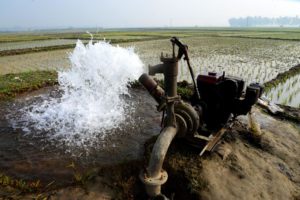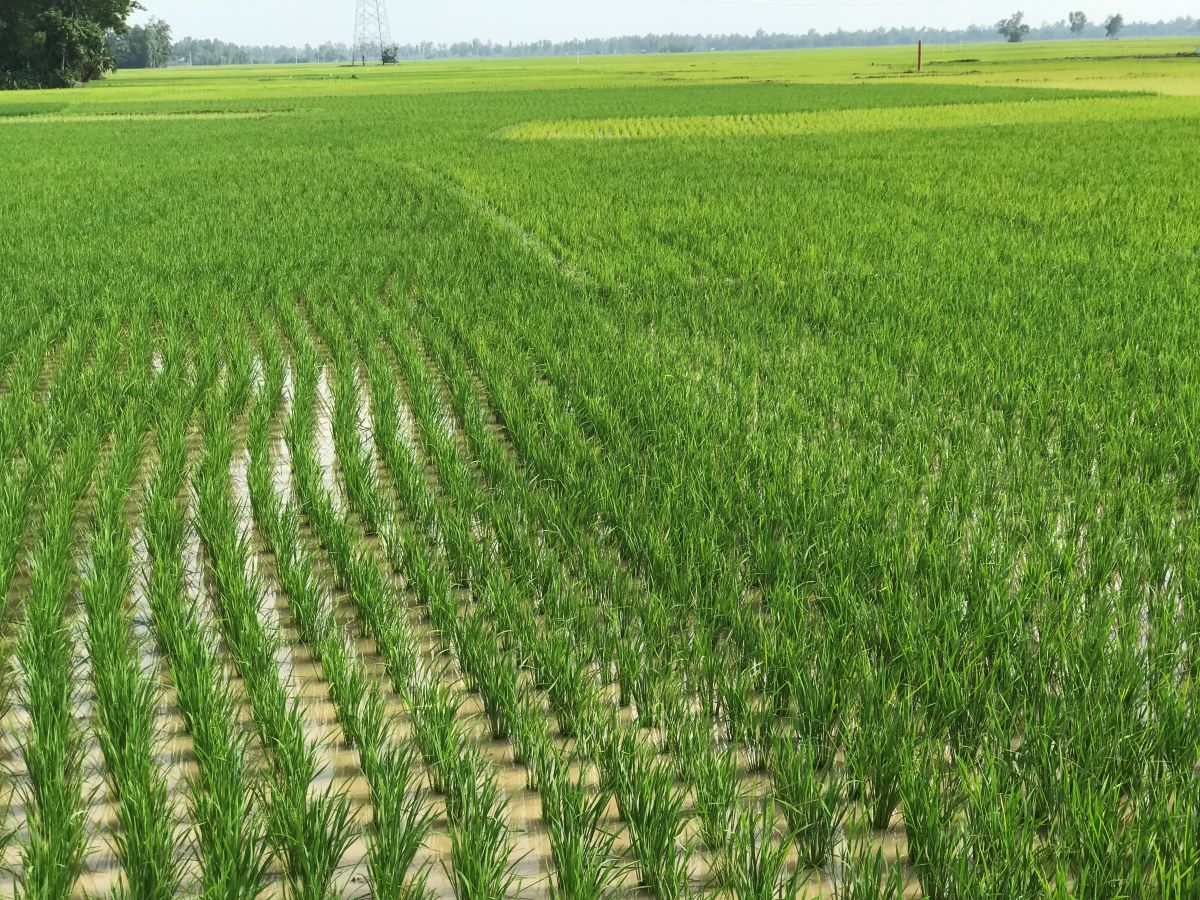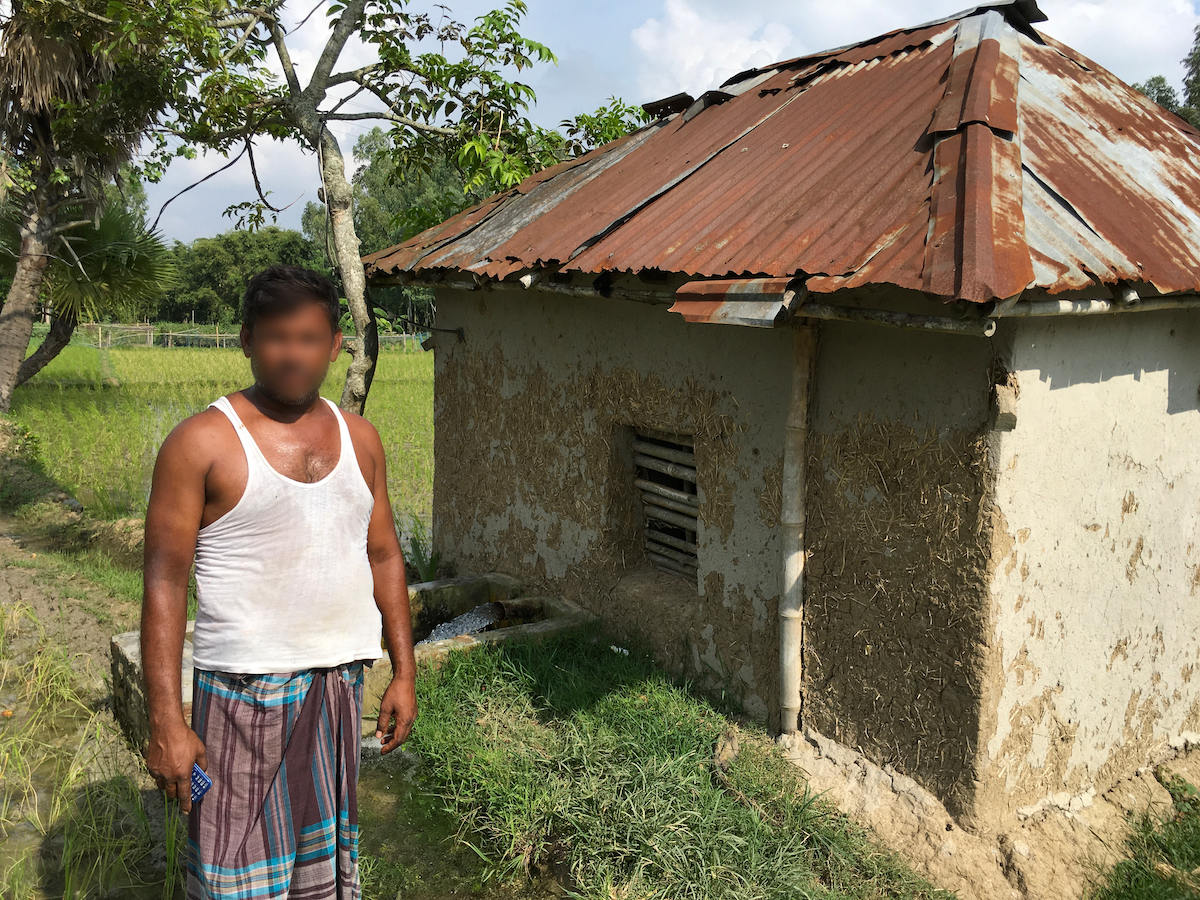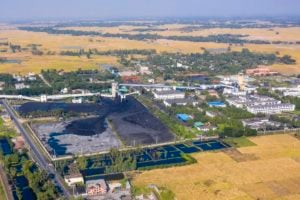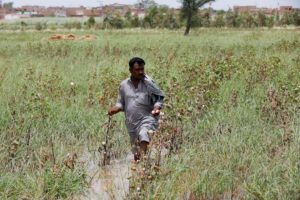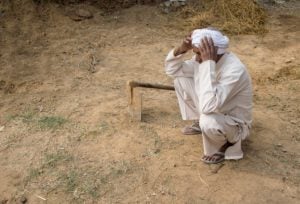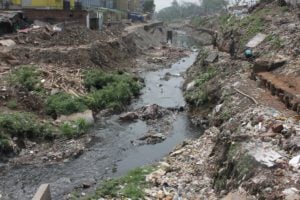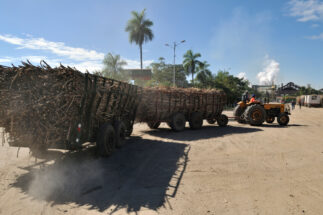In late August 2022, Fulu Mia was confronted with a stark choice: whether to spend the little money he had on treating his wife’s medical condition, or to buy water for his paddy fields, which were drying up even though it was the middle of the rainy season. His wife, initially diagnosed with pneumonia, now suffers from abdominal pain and struggles to breathe. Her treatment cost 33,000 Bangladeshi taka (about USD 320), and 66-year-old Mia had put aside BDT 2,000 (USD 20) towards it.
Instead, he had to hand the money to the owner of a shallow tubewell (STW). The STW owner supplies water to the farmers of Hangsharaj village in Nilphamari district, northwestern Bangladesh.
“During Aman [monsoon] season, we usually do not need irrigation. But this year, unusually a heatwave is going on. My paddy fields are drying up,” Mia, who speaks publicly about the problems farmers experience as a result of the region’s water system, told The Third Pole on 25 August 2022. Temperatures in this part of Bangladesh have risen over the past 40 years, while rainfall has fallen, leading to drought – likely an impact of climate change.
“Unless I irrigated the land immediately, the Aman paddy would not fruit. I went to my motorwala [shallow tubewell owner] and begged for water,” he said. Mia offered to pay after the harvest, because he needed to use the money for his wife’s treatment, but says the local motorwala told him: “No water without advance payment.”
If he stops selling water, we cannot grow paddy and we will starveFulu Mia, farmer in northwest Bangladesh
“I paid him the whole amount – otherwise, we would have starved in the coming months,” he said. “I can delay my wife’s treatment, not irrigation.”
There is no alternative source of irrigation to the STW in Hangsharaj.
“All of the farmers of my neighbourhood must turn to him for water every season. If he stops selling water, we cannot grow paddy and we will starve,” said Mia.
In July, the standard rate for using water from the STW was BDT 180 (nearly USD 2) per bigha (0.13 hectares) per hour. During the heatwave the price rose to BDT 500 (about USD 5), Mia said.
“The paddy field will need more irrigation in the coming weeks. I am worried how I will manage money,” said Mia. As of late November 2022, he was still struggling to afford his wife’s treatment, and instead was rubbing mustard oil on her chest to ease some of her suffering.
Fulu Mia is one of millions of farmers facing an irrigation crisis in Bangladesh’s 16 drought-prone but fertile northwestern districts. These sit within the Barind Tract, a geographic region that extends into the neighbouring Indian state of West Bengal. The area produces nearly 40% of Bangladesh’s rice, Wais Kabir, former executive chair of the country’s most important agricultural research institution, the Bangladesh Agricultural Research Council (BARC), told The Third Pole.
Problems with irrigation date back to the 1970s, when the waters of the Ganga and Teesta rivers were diverted by India before they entered Bangladesh. This, together with the effects of drought, reduced the amount of water in rivers, ponds and other bodies of surface water in the region. As this was happening, Bangladesh boosted motor-powered irrigation using groundwater. In the Barind Tract, a new moneyed and influential group has emerged, referred to as motorwalas (owners of motors) or paniwalas (owners of water), who install shallow tubewells (STWs) that pump out groundwater.
With little oversight from the government, these ‘water lords’ can charge aggressive prices for water. Government-appointed motor operators set prices in tandem with the water lords, which vary depending on demand.
Matia Chowdhury, a former agriculture minister who is currently deputy leader of Parliament, told The Third Pole in November 2022 that she had raised the issue in Parliament in 2014, stating that the new water lords had replaced the British colonial-era landlords. “The landlords used to exploit the marginal farmers once in a year. But these water dealers exploit poor farmers round the year,” she said.
Despite the fertility of the land, agricultural output has historically been low in Bangladesh.
“One of the major causes of crop failure and famines is lack of irrigation facilities. The introduction of a modern irrigation system drastically changed Bangladesh’s agricultural landscape. Irrigation is one of the factors that makes us a food-sufficient country from chronic food deficit,” Hamidur Rahman, a former director-general of the Department of Agriculture Extension, told The Third Pole.
In the 1960s, motorised irrigation was introduced by the government body currently known as the Bangladesh Agriculture Development Corporation (BADC). In the late-1970s, diesel-fuelled shallow tubewells were brought in, and in 1985 BADC engineers introduced a locally improvised deep tubewell (DTW). As a result, rice production increased steadily, from 118,000 metric tonnes in 1969 to 364,000 metric tonnes in 2018-19.
But the situation in the 16 dry northwestern districts was different to the rest of the country. In 1992, the government created the Barind Multipurpose Development Authority (BMDA) under the BADC to provide irrigation services to the farmers of the northwestern districts.
The BMDA installed DTWs to provide irrigation using groundwater. But the BMDA could not provide irrigation services everywhere. With the permission of the local administration, the private sector was allowed to install STWs for irrigation. A BADC report (not available online) says that across Bangladesh, smaller-scale irrigation methods such as shallow tubewells covered over 72.5% of the land in the Boro rice (dry) season in 2020-21.
Farmers ‘helpless’ in private water system
Ravi Paal* lives in a village in Mohadevepur subdistrict, in the drought-prone northwestern district of Naogaon. The 25-year-old, who is a member of a repressed caste in a Hindu-dominated community, told The Third Pole that the local STW owner had ruined his crops.
Paal owns 19 katha (about a tenth of a hectare) of paddy fields on high land and 17 katha of low-lying land. Showing his fields to The Third Pole, he said the low-lying land was waterlogged throughout the year.
“I told the paniwala that I would not buy water for this land because irrigation is not necessary here. When I asked for water for the high land, they attached a condition: unless I bought water for the low-lying land, they would not give me water for the high land,” he told The Third Pole in June last year.
“They gave so much water in the low-lying paddy field that the yield dropped by 50%,” said Paal. “I would normally get 20 maund [about 750 kilograms] of paddy on this 17 katha land. But it came down to 10 maund [370 kilograms].”
Abid Hasnain*, a Muslim resident of same village as Paal, said he had the same experience.
“They will force you to buy water for low-lying land if you ask for water for a high-land paddy field,” the 55 year-old told The Third Pole.
“If one motorwala enhances the rate, others will immediately set the same rate,” said Hasnain, adding that he has quarrelled with the water lords several times. The farmers of the village said that the motor owners, whether Hindu or Muslim, are united in controlling prices. Likewise regardless of religion, or their marginalised or indigenous status, farmers are overcharged.
Anil Paal* (no relation to Ravi), from the same area, expressed the helplessness of the farmers.
They set the charges of irrigation at their whims. We are simply captivesKishore*, marginal farmer in Naogaon district
“There is no rain this rainy season. We cannot cultivate this season due to paucity of water. We have been captives in the hands of the motorwalas,” Anil Paal told The Third Pole. “The water costs at least 20% of our total agricultural expenditure,” he added.
The motorwalas insist on payment in advance. “But there are many insolvent farmers unable to make advance payments. What will they do?” Anil Paal said.
Kishore*, a marginal farmer in another village in Naogaon, told The Third Pole that all the power is with the Barind Multipurpose Development Authority (BMDA) operators and the STW owners.
“They set the charges of irrigation at their whims. We are simply captives, helpless,” he said. “If we do not pay in advance, they would stop irrigation at a time when the paddy matures. In many cases, the farmers pay them by selling their cattle.”
The rush to become water lords
Investing in an STW is lucrative. A machine costs around BDT 500,000 (USD 5,300), people involved in the business told The Third Pole. The government provides electricity to STW owners at a subsidised rate.
An agent who works for the STW owner for the village where Paal and Hasnain live told The Third Pole that one STW irrigates up to 100 bigha (14 hectares). He said farmers must pay BDT 1,500 per bigha during the rainy season, but rate rises to BDT 2,000 during the dry season.
“We have not unilaterally set the rate. We are charging according to the rates set by all other STW owners,” he said, adding that “the business is good”.
“The farmers within our scheme have no alternative. People are begging for water,” the agent said. “We have to pay the electricity bills and go for repairs and maintenance of the machines. Other than that, we have no expenditure because water comes from underground.”
Selim Reza, an assistant engineer at the BMDA office in Mohadevpur subdistrict of Naogaon, told The Third Pole that under a rule instituted by the government in May 2019 there is supposed to be 250 metres between two STWs with a capacity of 0.5 cubic feet per second, or cusec. There is meant to be 500 metres between a DTW with a capacity of 2 cusec and an STW.
“But this is hardly maintained. Every year we get up to 50 applications to install new STWs,” he said.
“In Mohadevpur, there is no further scope for approving installation of STWs. We see a saturation here. But some of the influential people [still] get approval,” said Reza, who as part of his BMDA role worked as the member secretary of the local irrigation committee headed by the local administration chief.
“Recently we carried out an investigation and detected nine people have installed STWs in close proximity, in violation of the government rule. We are going to take action against them,” he said.
Abdur Rashid, executive director of the Barind Multipurpose Development Authority, admitted that there have been violations in setting up STWs.
“The local administration head is the chief of the upzilla [subdistrict] irrigation committee that approves the application of setting up of STWs. The BMDA official is the member secretary of the irrigation committee. But we cannot always apply the law owing to pressure from the local influential people. We are forced to give approval when they put up pressure,” he told The Third Pole on 19 January 2023.
Committee-operated tubewells are also a problem
It is not just privately run shallow tubewells that are a problem. The deep tubewells (DTWs) installed by the BMDA are operated by resident committees, which employ a supervisor to run the pumps.
The operators charge farmers the same amount as the STW owners to irrigate their land, and famers are similarly at the mercy of those who own the resource. Marginalised groups and indigenous communities are particularly vulnerable to exploitation.
In March 2022, two indigenous Santal farmers committed suicide in Nimghutu village, in the northwestern district of Rajshahi, after the pump operator of a DTW refused to irrigate their paddy fields.
Fazle Hossain Badsha, an MP from Rajshahi, told The Third Pole in June and August 2022 that local influential people – who are intimately linked with water operations as they are able to get tubewell permissions – tried to cover up the deaths of the two indigenous farmers, which is a sensitive political issue in Bangladesh. Instead, they spread the rumour that the two had drunk themselves to death.
“Before committing suicide, the two Santals told their mothers that they would have to starve in the coming months as the operator turned down their request to give water to paddy fields. Then they drank the insecticide they bought to apply in their paddy fields,” Badsha said. “Had I not intervened, the police would not have investigated.”
The operator is in jail as charges that they exploited their position are being investigated.
Farmers in one village in Naogaon district alleged that the local operator of the BMDA deep tubewell hiked the rate for irrigation during the 2022 rainy season.
We are the puppets of the STW owners and the DTW operatorsAbdul Rashid*, farmer in Naogaon district
“Previously, we used to get water at the rate of BDT 1,500 per bigha. But this season the operator has set a new rule. Now we have to buy water per hour. He will charge at the rate of BDT 300 per hour,” Karimul Islam*, a marginal farmer from Prodhankundi village, told The Third Pole.
“If we agree on an hourly contract, we have to spend BDT 3,000 [per bigha] for the 10 spells of irrigation,” he said.
Abdul Rashid*, a farmer from Fazilpur village in Naogaon, told The Third Pole that farmers have no protection.
“We are the puppets of the STW owners and the DTW operators. When the STW owners increase the charge, the DTW operators do the same. If they stop giving water, the farmers have no other alternatives,” he said.
“The Barendra [BMDA] also operates some solar power pumps, but they charge the same amount. This is really frustrating,” said Rashid.
Political concern over dropping groundwater and exploited farmers
Another consequence of the current irrigation regime in northwest Bangladesh is an alarming drop in groundwater levels. Research shows that although crop production has been boosted since the 1980s, the water table is falling by 1.37 feet per year during the wet season and 0.72 ft per year during the dry season.
“I several times said in Parliament that the Barendra Multipurpose Development Authority and the private water lords have been causing catastrophe in the whole northern districts by extracting huge quantities of groundwater. This is not sustainable. Every year we see a huge fall in groundwater levels,” Badsha, the MP from Rajshahi, told The Third Pole. He said the government should intervene to stop excessive use of groundwater.
He said that there are two big problems with the current system: the sharp drop in groundwater levels and the fact that the power subsidy assigned for farmers is being monopolised by the water traders.
“Our farmers and the whole agriculture system have been captive in the hands of the water traders. They bribe the government officials to get permission for setting up pump machines to extract groundwater,” said Badsha.
“We have many rivers. We must find out ways for using surface water for sustainable agriculture,” he suggested.
On this, Rashid, the BMDA’s executive director, said: “You have to think that we cannot switch to surface water for irrigation overnight. It needs transition. The process has been on, and by 2030 the lion’s share of irrigation will come from surface water.”
* Some names have been changed
